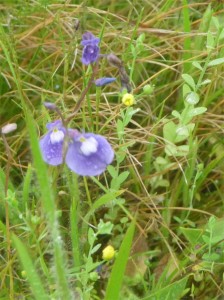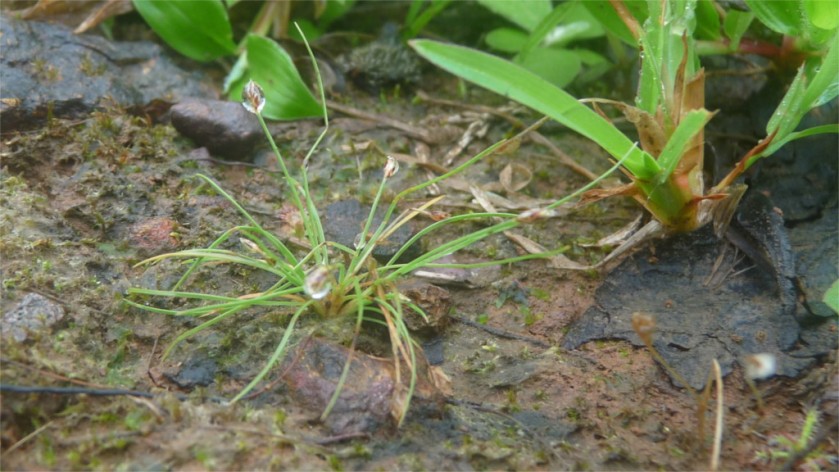When I listen to fellow tourists during trips to jungles, it is clear that the stars are the carnivores: tigers, leopards, even wild dogs. In fact I often meet people who do not enjoy the strangeness of tropical jungles, and consider a trip wasted unless they see a tiger close up. So it is also during a visit to the kilometer-high plateau of Kaas: the carnivorous plants of this inselberg enjoy stardom, but are seldom seen or recognized. These stars are the sundew (featured photo) and the small purple flowers of the bladderwort (below right).
The bladderworts, such as the Utriculata purpurea whose purple flowers you see in the photo alongside, are the tiger of this jungle. These bladderworts are rootless plants that float on patches of water. I saw them in growing in close conjunction with other small herbs. Since I was a tourist and not a biologist, I did not try to separate them out to check whether they are free floating. The close association with other plants makes it likely that they float on a mat of vegetation. A recent study found large communities of living algae and rotifers in the bladders of some individuals of this species growing in Florida. So it is possible that Seeta’s tears, as this species is called locally, derives a benefit from supporting an ecosystem within itself, rather than eating everything. To push the analogy further, U. purpurea, may not be the Kumbhakarna it is often thought to be, waking from sleep during the monsoon to eat everything that lands in the bladder. By supporting communities of living creatures, it may be closer in function to Seeta’s mother: the earth itself.
At the moment I care more about Drosera than the origin of all the species in the world.
Charles Darwin (19860) in a letter to Charles Lyell
Carnivorous plants are usually found in wet and nutrient poor soils. Like many of these plants, the sundew is poor at competing with neighbouring plants for light. We found three of them, probably Drosera Indica, in patches of ground below the roots of Topli Karvi bushes. I often wondered about whether the sundew is beneficial to humans or not, and was pleased to see a positive answer. Apparently Drosera preferentially eat mosquitoes, midges, and biting flies, which would otherwise proliferate in these wetlands, and therefore pose public health hazards.
While watching tigers you may also watch birds. While trying to take the featured photo of the sundew, I thought I saw a little tuft of grass growing next to it. When I looked at it again I thought that maybe it was not grass but a lily. I took a photo, and later saw that I was mistaken again. The tiny flowers at the tips of some of the stalks were clearly protected by a single modified leaf. This is called a spathe. Its presence means that the plant belongs to the family Araceae and so is cousin to Irises and Crocuses. I wish I’d looked more carefully at it in the field and tried to take a closer photo of the unfurled spathe and the inflorescence which it protects. Not having made this observation, I have no identification. Please help, if you can.
Just in case you like to read about plants, I will leave you to settle down to read this interesting scientific review of the state of our knowledge of carnivorous plants.



muito bom! conheço algumas plantas carnívoras, do sul do Brasil.
LikeLike
Thank you. Yes, Brazil is another hotspot for them.
LikeLiked by 1 person
Very interesting post! I’d love to visit the jungle for the plants 😊 Though I’d probably be worried about the insects, spiders etc…. But tropical plants fascinate me!
LikeLike
Thank you. These plants grow on an open meadow, not a jungle. That should save you some worries.
LikeLiked by 1 person
Great! I’m there!
LikeLiked by 1 person